About The Author
Hello! From Chuchura (in Hooghly District) and a foodie, I created this blog with a mission to preserve the food of the land; with a message to encourage and promote clean and real food. I hope you enjoy and gain out of this blog, happy reading!
Looking forward to read and hear your feedback.
A rainy day, a religious occasion like Saraswati Pujo or Durga Pujo, a feverish feeling or an upset stomach; a Bengali Khichdi or khichuri is the king of all times – good or bad.
Short of time? Hungry and want a plate of delicious khichdi in a jiffy? Try out the quick and easy khichdi recipe.
As I sit to write this guide and share it with you, I am reminded of all those occasions, the celebration and the people associated with each of them – starting with the thakur (a Bengali cook) who prepared khichuri in a huge pot that can feed hundreds; to my neighbors and dida (maternal grandmother) who would cook the best Bengali khichdi and labra (a type of Bengali mixed vegetable) every time there was a religious festival.
This dish is a favorite and a necessity. Khichuri perfectly defines comfort food for the Bengalis.
By the end of this guide you will know how to prepare a fragrant, delicious, lip-smacking and satisfying pot of khichuri or Bengali khichdi.
This is an assurance I provide because I have considered every nuance and detailed them out in this guide.
So follow along!
What You Will Learn
This is what you will learn in this Bengali khichdi guide.
- What is Khichuri?
- What makes Khichuri so special?
- How to make Bengali Khichdi?
- Interesting Facts & Trivia
What is Khichuri?
Khichuri is a Bengali khichdi, which is a porridge of rice and dal along with vegetables and spices. It can be mild, spicy, runny, thick depending on individual preferences and need.
For example, if you have an upset stomach or feverish feeling, you would crave for a mild khichdi with running consistency.
The dish involves roasting shona mug dal, a variant of moong dal and dry frying of raw rice separately before cooking both these ingredients together with vegetables and spices.
The result is a fragrant, delicious one-pot meal that is considered a comfort food for millions of Bengalis around the world.
What Makes Bengali Khichdi so Special?
Before you crank up the oven to prepare this one-pot, here’s why the dish is so special for every Bengali. You can consider these factors as the end goal to achieve a successful khichuri or Bengali khichdi.
Fragrant
A bengali khichdi is a special dish and hence it should be fragrant.
The dish should have the fragrance of the gobindobhog rice which is the most important element of the dish.
A second fragrance that wafts towards you is from the use of desi ghee. Bengalis mostly prefer desi gawa ghee and Jharna ghee is the most preferred brand.
Nutty Flavor
The nutty flavor from the roasted dal is an important factor in a Bengali khichuri. This is the result of slow roasting the dal on medium flame for a few minutes at the start of the preparation.
Flavorsome Potato & Cauliflower
Bengalis and potatoes are inseparable. The potatoes should be well cooked and soft. It should be mashable using only the thumb and index finger.
Another important vegetable during the winter is the presence of cauliflower that packs flavor and delivers deliciousness on the plate.
Creamy Texture
Of course, you can prepare a khichuri that is watery, or one that isn’t watery.
A creamy texture, however, defines the perfect consistency of a Bengali khichdi. That does not mean that you have a mash of the rice, dal and veggies that create a lump when served.
Now that you know how the perfect khichuri should be, it’s time to get out hands dirty.
How to Make Bengali Khichdi?
Let’s get down with the ingredients first and then the procedure.
Serves: 4 individuals
Ingredients for Bengali Khichdi Recipe

- 2 cups Gobindobhog rice
- 2 cups of split moong dal (shona mug dal)
- 1 bowl of cauliflower florets chopped in bigger sizes
- 2 medium or large sized potatoes
- 3 tablespoons of mustard oil
- 1 tablespoon of desi ghee
- Whole garam masala for tempering which includes
- 2 dried red chilies
- 2 bayleaf
- 3 to 4 peppercorns
- 3 to 4 cardamoms
- 1 inch stick of cinnamon
- 2 cloves
- 1 teaspoon of whole cumin seeds
- 1 inch ginger finely chopped or ground to a paste
- 1/2 tablespoon of turmeric powder
- 1/2 tablespoon of cumin powder
- 1 teaspoon of coriander powder
- 2 green chilies
- 2 medium tomatoes chopped quarterly
- 1 tablespoon of sugar
- salt to taste
- 15 to 20 cups of hot water
Step by Step Instructions for Bengali Khichdi Recipe
In this section, I will guide you through each of the steps in details so that you can make a good pot of khichuri in the very first attempt.
Please note that the steps are detailed out to ensure the best results, a bit of deviation would be still fine.
Step 1: Preparation (15 minutes)
The preparation for a Bengali khichdi involves getting the right amount of rice and dal and ensure the right cuts of vegetables.
Measuring the Rice and Dal
Ensure that you properly measure the rice and the dal. It should always be equal in portion. So if you take one cup of gobindobhog rice, you should take one cup of shona mug dal.

Measuring & Chopping the Vegetables
You can use any vegetables you wish. A bengali khichdi, however, predominantly uses potatoes and cauliflower florets.
You can cut the potatoes in halves, which means one potato will serve two persons.
Cut the cauliflower florets in bigger sizes, because you would not want the cauliflower florets to melt in the khichuri and reduce itself to a mash.
Step 2: Wash the rice and dry it (5 minutes)
Wash the rice in water for a few times. This is to ensure that all the dirt and starch are removed.
After you have washed the rice, spread it on a plate big enough and allow the rice to dry. Since we will dry roast the rice later, it is important to ensure that there is no moisture in the rice.
You can also keep the rice under a ceiling fan to speed up the process.
Step 3: Roast the dal (5 minutes)
Dry roast the dal in a kadai for a three to four minutes. The goal here is to induce a nutty flavor in the dal.
How long should you roast the dal? The answer is – until half of the dal have changed their color from golden yellow to brown. A nutty flavor will fill the kitchen once the dry roast process completes.
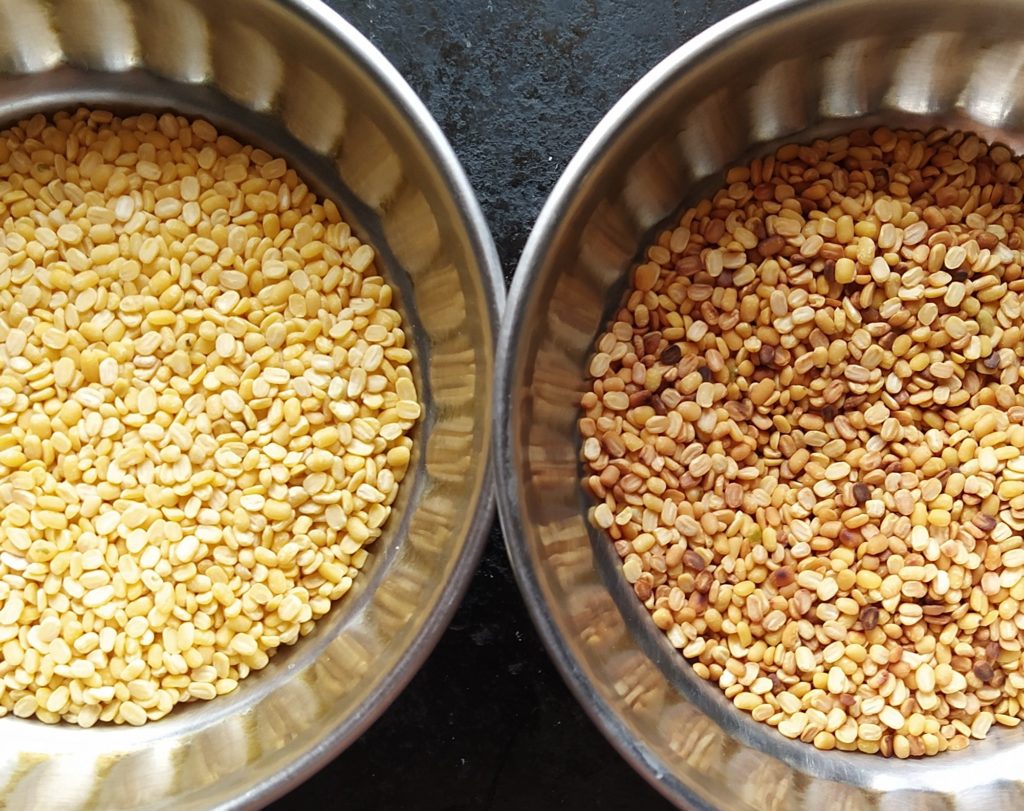
Step 4: Wash the dal (2 minutes)
Wash the dal only once under cold water. Remember to not over wash the dal as it will undo the hard work you did previously while roasting it. Over washing the dal will remove its nutty flavor.
Step 5: Fry the raw rice (5 minutes)
In a kadai, pour the rice and dry roast it for 5 minutes using a spatula. With time the rice will have a transparent feel to itself.
Once done, remove from heat.
Step 6: Fry the vegetables separately (10 minutes)
Fry the potatoes using a pinch of turmeric powder till all the sides of the potato have a golden outer covering. Keep aside once done.
Next, fry the cauliflower in a pinch of turmeric.
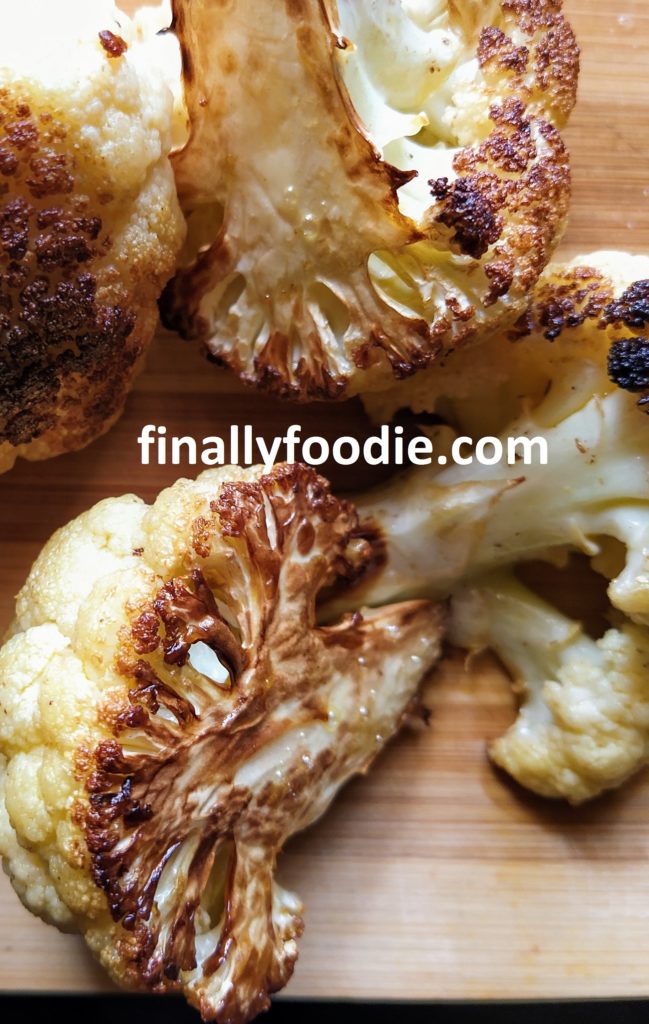
You can consider other vegetables too.
Step 7: Cook together (25 minutes)
It is now time to bring all the ingredients together and cook the bengali khichdi recipe.
- Take a wok and when hot pour in the oil
- Once the oil is heated up, drop the ingredients listed under whole garam masala in the ingredients section and cook for a few minutes till you smell the aroma from the spices
- Throw in the cumin seeds
- Once the cumin seeds start spluttering, put in the chopped ginger and fry until the raw smell goes
- Drop in the chopped tomatoes and the dry spices like turmeric powder, cumin powder and coriander powder
- Fry the powdered spices. If required, splash water to ensure that spices do not burn
- Once the spices are cooked, add in the rice and the dal
- Mix properly and cook for a couple of minutes
- Add the hot water and salt and bring to a boil. Taste the seasoning and adjust if required
- Cover the wok and cook for 15 minutes. Check every few minutes to ensure that the dal does not stick to the bottom of the wok and get burnt. If required, add hot water
- Add the green chilies and sugar and cook for another 5 minutes to the desired consistency. Continue with regular stirring to avoid the bengali khichdi from sticking to the bottom of the pan and burning
- Put off the flame and take off the wok from the oven
Step 8: Serve hot
Khichuri is best served hot along with some fries. The steam from a freshly cooked bengali khichdi evokes hunger and delight.
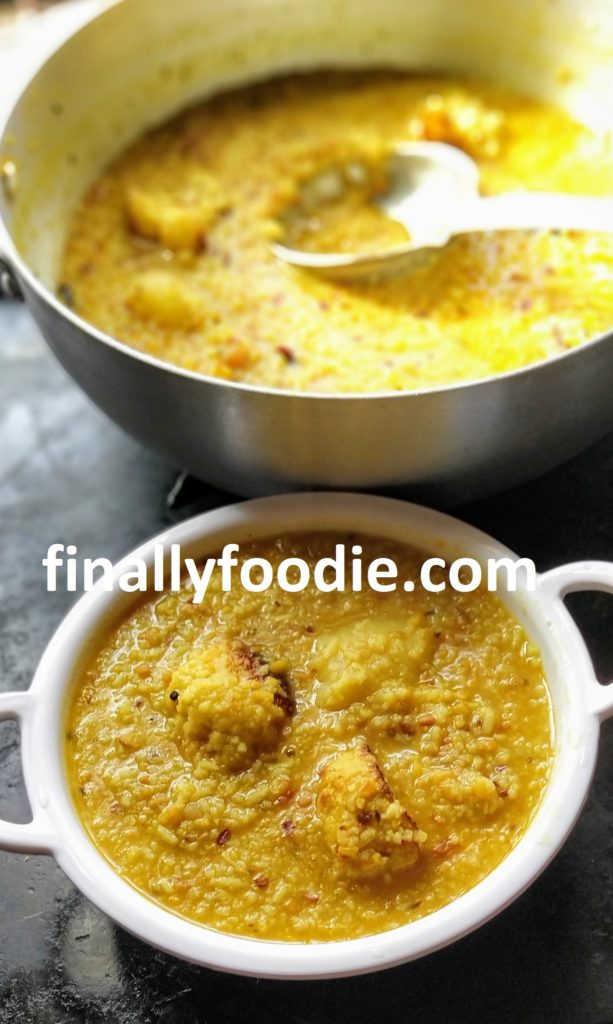
Happy eating!
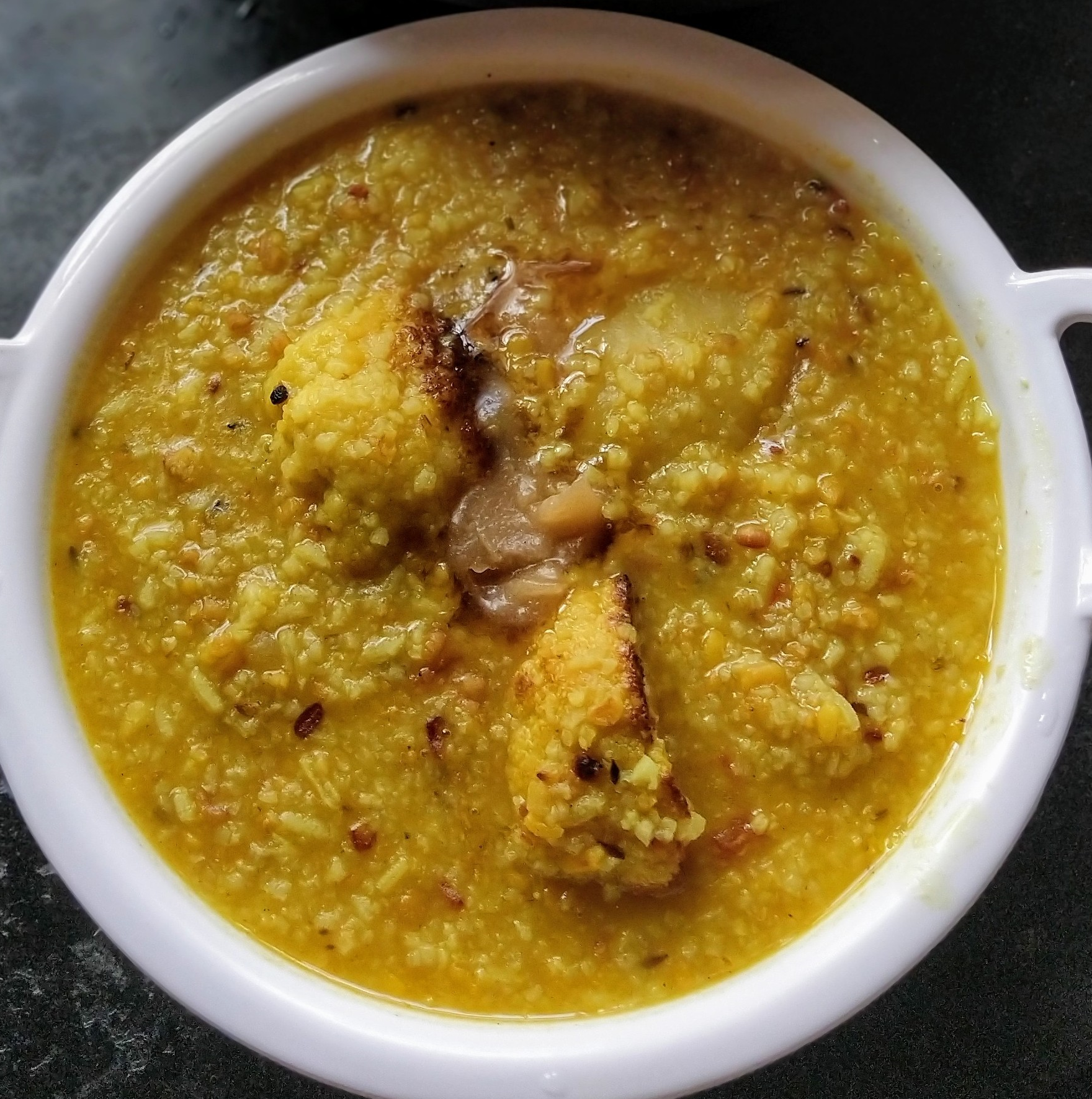
Note
The equipment & ingredient quantity provided in this recipe is to assist you in cooking this dish. Feel free to experiment with your ingredients. Remember that we all have different set, size & shape of kitchen tools in our pantry.
Equipment
- Wok or kadai
- Ladle
- Preparation and serving bowls
Ingredients
- 2 cup rice preferably gobindobhog rice
- 2 cup dal preferably split moong dal
- 1 bowl cauliflower florets cut in bigger chunks
- 2 pieces potato cut in halves
- 3 tbsp mustard oil
- 1 tbsp desi ghee
- 1 tsp whole cumin seeds
- 1 inch finely chopped ginger or half tablespoon ginger paste
- 1/2 tbsp turmeric powder
- 1/2 tsp cumin powder
- 1 tsp coriander powder
- 2 pieces green chilies
- 2 pieces medium tomatoes chopped quarterly
- 1 tbsp sugar
- salt to taste
- 15 to 20 cups hot water
Whole Garam Masala for tempering
- 2 pieces dry red chilies
- 2 pieces bayleaf
- 4 pieces peppercorns
- 4 pieces cardamom
- 1 inch stick of cinnamon
- 2 pieces cloves
Instructions
- Wash the rice repeatedly to remove the dirt and starch
- Spread the rice on a plate and allow to dry completely
- In a wok or kadai, dry roast the dal for 4-5 minutes until a beautiful aroma fills the kitchen and the dal changes color

- Separate the dal in a bowl
- Wash the dal in cold water only once
- In a wok, heat oil and fry the potatoes with a pinch of turmeric until the potato pieces of the bengali khichdi turn golden in color
- Separate the potato and proceed to fry the cauliflower florets in the same way
Cooking the Khichuri or Bengali khichdi
- Heat a wok and pour in oil
- Once the oil reaches the smoking point, temper with the spices mentioned under whole garam masala in the "ingredients" section
- Put in the cumin seeds and allow to crackle
- Throw in the chopped ginger and fry until the raw flavor is gone
- Drop in the chopped tomatoes
- Add cumin powder, coriander powder, turmeric powder
- Cook the spices till the raw smell disappears. If needed splash water to ensure that the spices do not burn
- Add in the rice and dal
- Mix and fry for a couple of minutes
- Add hot water and salt and bring to a boil
- Taste the seasoning and if required add in more salt
- Cover the wok and cook for 15 minutes.
- Check every few minutes to ensure that the dal does not stick to the bottom of the pan and get burnt. If required, add hot water
- Add green chillies and the sugar
- Cook for another 5 minutes to the desired consistency. Keep stirring to prevent the bengali khichdi from sticking to the bottom of the wok and burning
- Put off the flame
- Serve hot with fries and/or pickle
Notes
- The quantity for rice and dal should always be 1:1 for optimum flavor
- Shona mug dal is the best choice of dal while preparing khichuri
- Gobindobhog rice is the preferred variety of rice for this dish
- Do not over-wash the dal. It will lose its nutty flavor
- Always keep a jar of hot water near. You can use this to maintain the desired consistency
- Grated coconut provides the best flavors. You can substitute with desiccate coconut powder as well which is easily available in the local grocery shops
- A dollop of ghee served with a plate of hot khichuri always work wonders
Important Points to Remember while Preparing Bengali Khichdi
- The quantity for rice and dal should always be 1:1 for optimum flavor
- Shona mug dal is the best choice of dal while preparing khichuri. It is a variety of small moong dal that appears golden in color. It looks like below (image goes here)
- Gobindobhog rice is the preferred variety of rice for this dish. It is a small, short-grained and scented variant of rice that you can find in most neighborhood grocery shops. This variant of rice is also used to prepare other Bengali-themed dishes like basanti pulao and payesh (kheer)
- Wash the rice properly as presence of starch tends to thicken and make the khichuri stick
- Do not over-wash the dal. It will lose its nutty flavor
- Always keep a jar of hot water near. You can use this to maintain the desired consistency
- Potato and cauliflower are important vegetables to consider. You can however substitute with any other vegetables for a healthier bengali khichdi
- Grated coconut provides the best flavors. If grating a coconut isn’t possible, use desiccated coconut or coconut powder that are readily available in most departmental/grocery stores
- A dollop of ghee served with a plate of hot khichuri always work wonders. Gawa ghee is rarely available outside Bengal, and the very famous Jharna ghee can be readily bought online.
Khichuri Side Dishes
Bengali khichdi is a one-pot dish and goes well without any side dishes. However, Bengalis love their khichuri with the following side-dishes.
- Beguni – Thinly sliced brinjals (or eggplants) deep fried in a batter of besan (or chickpea flour)
- Omlette – Takes less than 5 minutes, and completely changes the khichdi experience. This is a Bengali favorite when it comes to the dish
- Alu’r Dum – Potatoes cooked with spices and tastes great with the one-pot meal
- Labra – A Bengali mixed vegetable dish with radish, greens and other vegetables and does not contain onion and garlic. This is mostly cooked during religious festivals
- Other vegetable stir fries – You can also include other vegetable stir fries like cauliflower florets, brinjal or eggplant, okra, etc.
- Papad – A universal phenomenon across India, this needs no introduction
- Chutney – A tomato chutney goes very well with a Bengali khichdi. You can also cook a plastic chutney (made with papaya) or a mango chutney
- Pickle – If all of the above sounds time consuming and too much work, there will always be a small jar of pickle in the kitchen or refrigerator. You can always slurp away with a spoonful.
Interesting Facts and Trivia
While serving khichdi to your family, friends or any other guests, share with them the following trivia regarding the khichdi.
- Khichdi is a very old dish and finds mention in the writings of Kautilya and Ibn Battuta
- Ibn Battuta, the famous traveller wrote about khichdi in 1200 AD
- 1500 years before Ibn Battuta wrote about khichdi, Kautilya wrote about this dish around 300 BC as being the staple meal for a gentleman
- While vegetarian khichdis are a norm, there are non-veg variants too. khichra is a non-veg khichdi that has five different kinds of lentils, rice and lamb as the main ingredients
- Kedgree is an anglo-Indian variant of khichdi among the British, though without the dal since British did not like them
- Koshary and mujaddara are two variants of khichdi from Egypt and Middle East respectively
I am confident that this guide would help you to cook a good pot of Bengali Khichdi in the very first attempt and provide a fulfilling experience.
Do try this out and share your experience with me.
Last but not the least, some promotion always makes me feel good. Please share the guide with your fellow foodies, family members, friends and relatives.
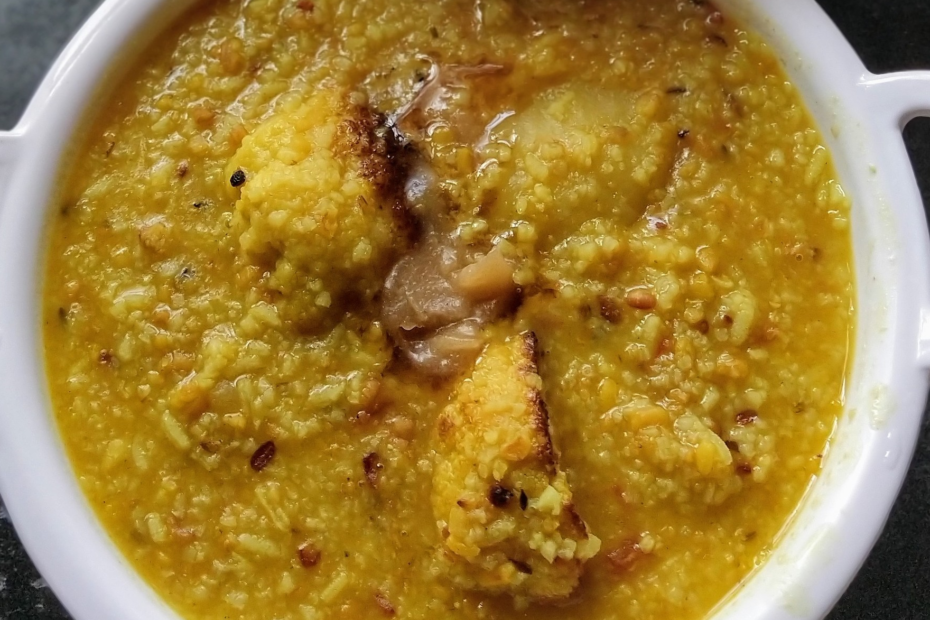

Pingback: Mighty Guide to Little / Kutki Millets: Cooking Mastery, and More!
Pingback: The Unpolished Millets Revolution: 10 Indian Brands Leading the Way - FinallyFoodie.com
Tried this recipe today & I took me back to my childhood days of Durga Pooja Prasad which we always looked forward to. Thanks a lot for detailed recipe
Pingback: Niramish Aloor Dum - A Simple & Delicious Bengali Wintry Affair
Pingback: Sheherwali Cuisine - A 300 Year Old Culinary Tradition of Murshidabad
Pingback: Easy and Quick Khichdi Recipe to Soothe Your Weekdays
Pingback: 6 Gobindobhog Rice Recipes You Will Fall In Love With
Pingback: Aloo Khosha Bhaja | Crispy Potato Peels
Pingback: Side Dish with Bengali Khichuri | 12 Ideas for Your Khichdi